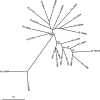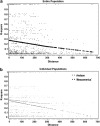Demographic factors shaped diversity in the two gene pools of wild common bean Phaseolus vulgaris L
- PMID: 23169559
- PMCID: PMC3668653
- DOI: 10.1038/hdy.2012.82
Demographic factors shaped diversity in the two gene pools of wild common bean Phaseolus vulgaris L
Abstract
Wild common bean (Phaseolus vulgaris L.) is distributed throughout the Americas from Mexico to northern Argentina. Within this range, the species is divided into two gene pools (Andean and Middle American) along a latitudinal gradient. The diversity of 24 wild common bean genotypes from throughout the geographic range of the species was described by using sequence data from 13 loci. An isolation-migration model was evaluated using a coalescent analysis to estimate multiple demographic parameters. Using a Bayesian approach, Andean and Middle American subpopulations with high percentage of parentages were observed. Over all loci, the Middle American gene pool was more diverse than the Andean gene pool (π(sil)=0.0089 vs 0.0068). The two subpopulations were strongly genetically differentiated over all loci (F(st)=0.29). It is estimated that the two current wild gene pools diverged from a common ancestor ∼111 000 years ago. Subsequently, each gene pool underwent a bottleneck immediately after divergence and lasted ∼40 000 years. The Middle American bottleneck population size was ∼46% of the ancestral population size, whereas the Andean was 26%. Continuous asymmetric gene flow was detected between the two gene pools with a larger number of migrants entering Middle American gene pool from the Andean gene pool. These results suggest that because of the complex population structure associated with the ancestral divergence, subsequent bottlenecks in each gene pool, gene pool-specific domestication and intense selection within each gene pool by breeders; association mapping would best be practised within each common bean gene pool.
Figures




References
-
- Acosta-Gallegos JA, Kelly JD, Gepts P. Prebreeding in common bean and use of genetic diversity from wild germplasm. Crop Sci. 2007;47:S44–S59.
-
- Arunyawat U, Stephan W, Stadler T. Using multilocus sequence data to assess population structure, natural selection, and linkage disequilibrium in wild tomatoes. Mol Biol Evol. 2007;24:2310–2322. - PubMed
-
- Astle W, Balding DJ. Population structure and cryptic relatedness in genetic association studies. Stat Sci. 2009;24:2310–2322.
-
- Becerra Velasquez VL, Gepts P. RFLP diversity of common bean (Phaseolus vulgaris) in its centers of origin. Genome. 1994;37:256–263. - PubMed
MeSH terms
Substances
Associated data
- Actions
- Actions
LinkOut - more resources
Full Text Sources
Research Materials
Miscellaneous

